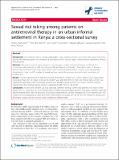| dc.contributor.author | Ragnarsson, Anders | |
| dc.contributor.author | Ekström, Anna Mia | |
| dc.contributor.author | Carter, Jane | |
| dc.contributor.author | Ilako, Festus | |
| dc.contributor.author | Lukhwaro, Abigail | |
| dc.contributor.author | Marrone, Gaetano | |
| dc.contributor.author | Thorson, Anna | |
| dc.date.accessioned | 2021-09-01T11:45:49Z | |
| dc.date.available | 2021-09-01T11:45:49Z | |
| dc.date.issued | 4/18/2011 | |
| dc.identifier.citation | Ragnarsson, Anders et al. “Sexual risk taking among patients on antiretroviral therapy in an urban informal settlement in Kenya: a cross-sectional survey.” Journal of the International AIDS Society vol. 14 20. 18 Apr. 2011, doi:10.1186/1758-2652-14-20 | en_US |
| dc.identifier.other | PMID: 21496354 | |
| dc.identifier.uri | http://repository.amref.org/handle/123456789/202 | |
| dc.description | ©2011 Ragnarsson et al; licensee BioMed Central Ltd.
This is an Open Access article distributed under the terms of the Creative Commons Attribution License (http://creativecommons.org/licenses/by/2.0), which permits unrestricted use, distribution, and reproduction in any medium, provided the original work is properly cited. | en_US |
| dc.description.abstract | Background
Our intention was to analyze demographic and contextual factors associated with sexual risk taking among HIV-infected patients on antiretroviral treatment (ART) in Africa's largest informal urban settlement, Kibera in Nairobi, Kenya.
Methods
We used a cross-sectional survey in a resource-poor, urban informal settlement in Nairobi; 515 consecutive adult patients on ART attending the African Medical and Research Foundation clinic in Kibera in Nairobi were included in the study. Interviewers used structured questionnaires covering socio-demographic characteristics, time on ART, number of sexual partners during the previous six months and consistency of condom use.
Results
Twenty-eight percent of patients reported inconsistent condom use. Female patients were significantly more likely than men to report inconsistent condom use (aOR 3.03; 95% CI 1.60-5.72). Shorter time on ART was significantly associated with inconsistent condom use. Multiple sexual partners were more common among married men than among married women (adjusted OR 4.38; 95% CI 1.82-10.51).
Conclusions
Inconsistent condom use was especially common among women and patients who had recently started ART, i.e., when the risk of HIV transmission is higher. Having multiple partners was quite common, especially among married men, with the potential of creating sexual networks and an increased risk of HIV transmission. ART needs to be accompanied by other preventive interventions to reduce the risk of new HIV infections among sero-discordant couples and to increase overall community effectiveness. | en_US |
| dc.description.sponsorship | The Swedish International Development Cooperation Agency (SAREC). | en_US |
| dc.language.iso | en | en_US |
| dc.publisher | BioMed Central | en_US |
| dc.subject | Antiretroviral treatment (ART) | en_US |
| dc.subject | Kibera | en_US |
| dc.subject | Nairobi, Kenya | en_US |
| dc.subject | Condom | en_US |
| dc.subject | Unprotected sex | en_US |
| dc.title | Sexual Risk Taking among Patients on Antiretroviral Therapy in an Urban Informal Settlement in Kenya: A Cross-sectional Survey | en_US |
| dc.type | Article, Journal | en_US |

